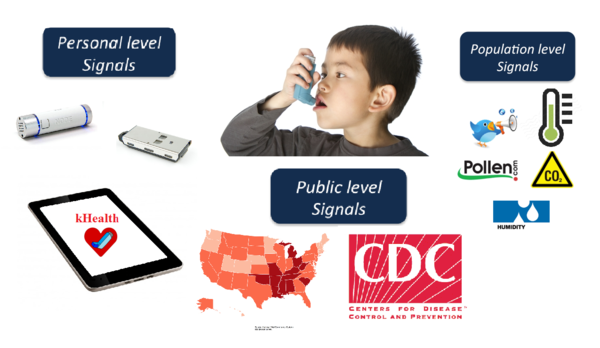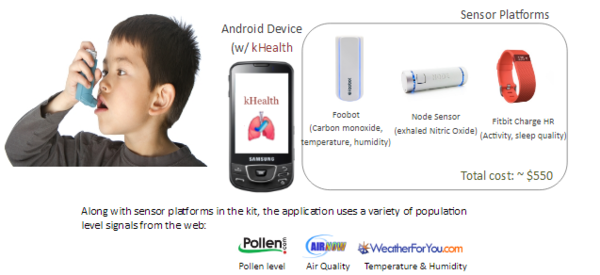KHealth: Semantic Multisensory Mobile Approach to Personalized Asthma Care
Contents
Motivation and Background
More than 25 million people in the U.S. are diagnosed with asthma, out of which 7 million are children [1]. Asthma related healthcare costs alone are around $50 billion a year [2]. Current reactive healthcare costs more than 17% of GDP in the US [3, 4]. Specifically, with the current reactive care for asthma, there were 155,000 hospital admissions and 593,000 ER visits in 2006 [16]. It is estimated that, by 2025, over 400 million people will be affected by asthma worldwide. With increasing adoption of mobile devices and low-cost sensors, unprecedented amount of data is being collected by people [5]. This data collection has exacerbated the problem of understanding the data and make sense of it. In this work, we explore the role of knowledge empowered algorithms in making sense of this data deluge in the context of Asthma assessment and management.
Asthma: Challenges and Opportunities
Asthma is a good example of a problem that spans Physical-Cyber-Social (PCS) systems. For example, consider all the health signals to be monitored for understanding Asthma exacerbations.
kHealth for Asthma
We tackle this important problem by a combination of active and passive sensing. Active sensing involves the patient in the loop (obtrusive) while the passive sensing does not involve patient involvement (unobtrusive). Using a novel approach of using low-cost sensors for continuous monitoring (active and passive sensing), we propose to develop algorithms that can understand the situation of a patient. Situation refers to the asthma control level based on symptoms and their severity.
kHealth Observations
Asthma is a multi-faceted problem and we propose a holistic solution for
Personal
Physiological: Wheezometer [6], Nitric Oxide [7], Accelerometer, Microphone, Contextual Questions
Environmental: Sensordrone [8], Dust Sensor [9], Location
Public Health
CDC [10], DCHC’s EMR Records (periodic manual review)
Population Level
Everyaware [11], AirQuality Egg [12], Allergy Alerts [13,14], Social Observations (e.g., tweets), Air Quality Index[15]
Copy of IRB
kHealth User Manual
References
[1] NHLBI description of Asthma, Available online at: http://www.nhlbi.nih.gov/health/health-topics/topics/asthma/
[2] Asthma related facts, Available online at: http://www.lung.org/lung-disease/asthma/resources/facts-and-figures/asthma-in-adults.html
[3] Squires, D. A., The U.S. Health System in Perspective: A Comparison of Twelve Industrialized Nations, June 2011, Available online at: http://bit.ly/oZwhFZ
[4] Health Costs: How the U.S. Compares With Other Countries, Available online at: http://www.pbs.org/newshour/rundown/2012/10/health-costs-how-the-us-compares-with-other-countries.html
[5] Quantified Self http://quantifiedself.com/
[6] Wheezometer by iSonea, Available online at: http://www.isoneamed.com/wheezometer.html
[7] Nitric Oxide Sensor, Available online at: http://nodesensors.com/product/oxa-gas-sensor-nitric-oxide-no/
[8] Sensordrone, a bluetooth enabled low-cost sensor for monitoring the environment, Available online at: http://www.kickstarter.com/projects/453951341/sensordrone-the-6th-sense-of-your-smartphoneand-be/
[9] Optical Dust Sensor, Available online at: https://www.sparkfun.com/products/9689
[10] Centers for Disease Control and Prevention, Available online at: http://www.cdc.gov/
[11] Everyaware, Sensing Air Pollution, Available online at: http://www.everyaware.eu/activities/case-studies/air-quality/
[12] Community-led sensing of AirQuality, Available online at: http://airqualityegg.com/
[13] National and Local Allergy Forecast, Available online at: http://www.pollen.com/allergy-weather-forecast.asp
[14] National Allergy Bureau Alerts, Available online at: http://www.aaaai.org/global/nab-pollen-counts.aspx
[15] Air Quality Index from United States Environmental Protection Agency, Available online at : http://www.epa.gov/
[16] Akinbami et al. (2009). Status of childhood asthma in the United States, 1980–2007. Pediatrics,123(Supplement 3), S131-S145.

